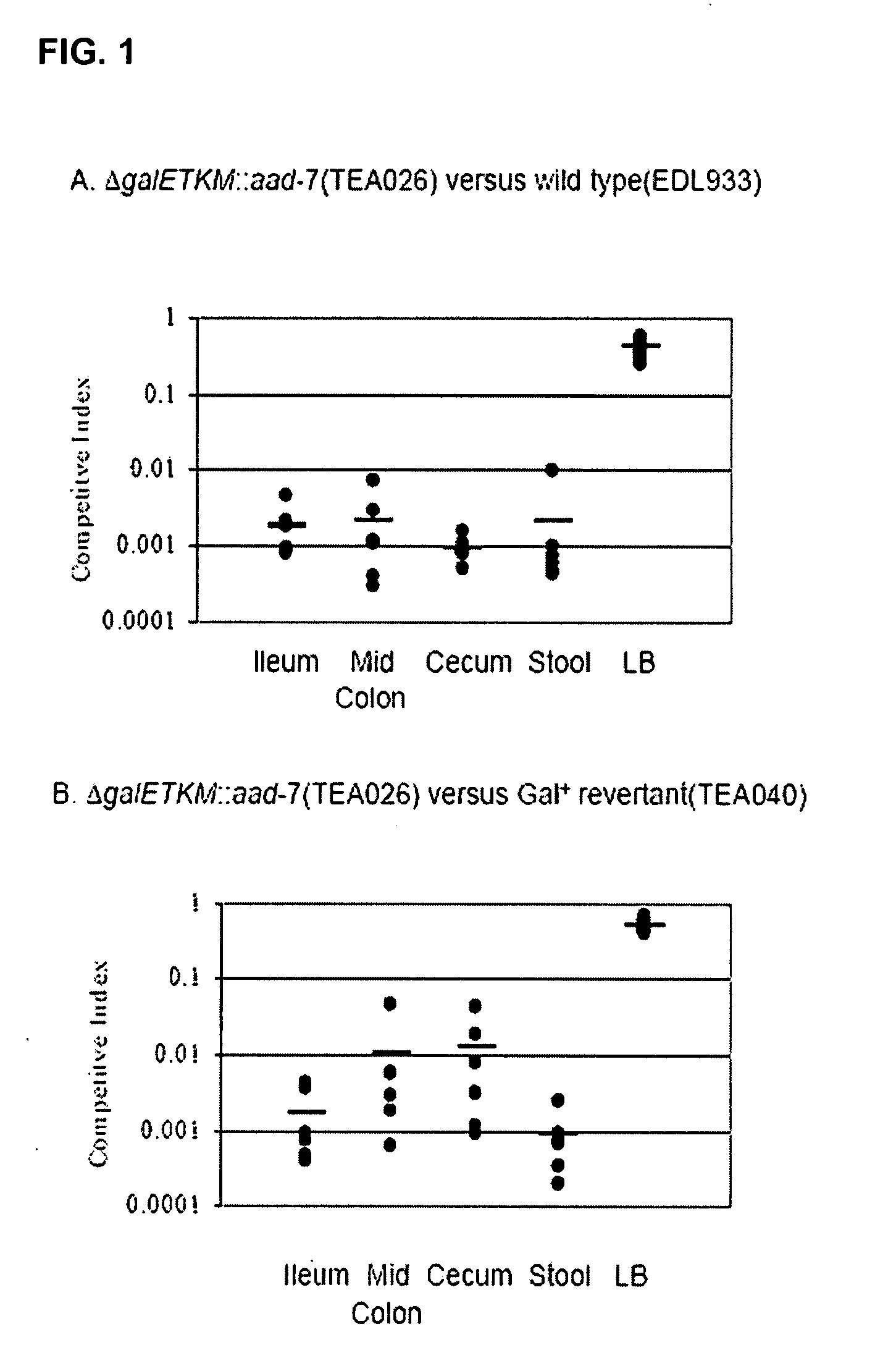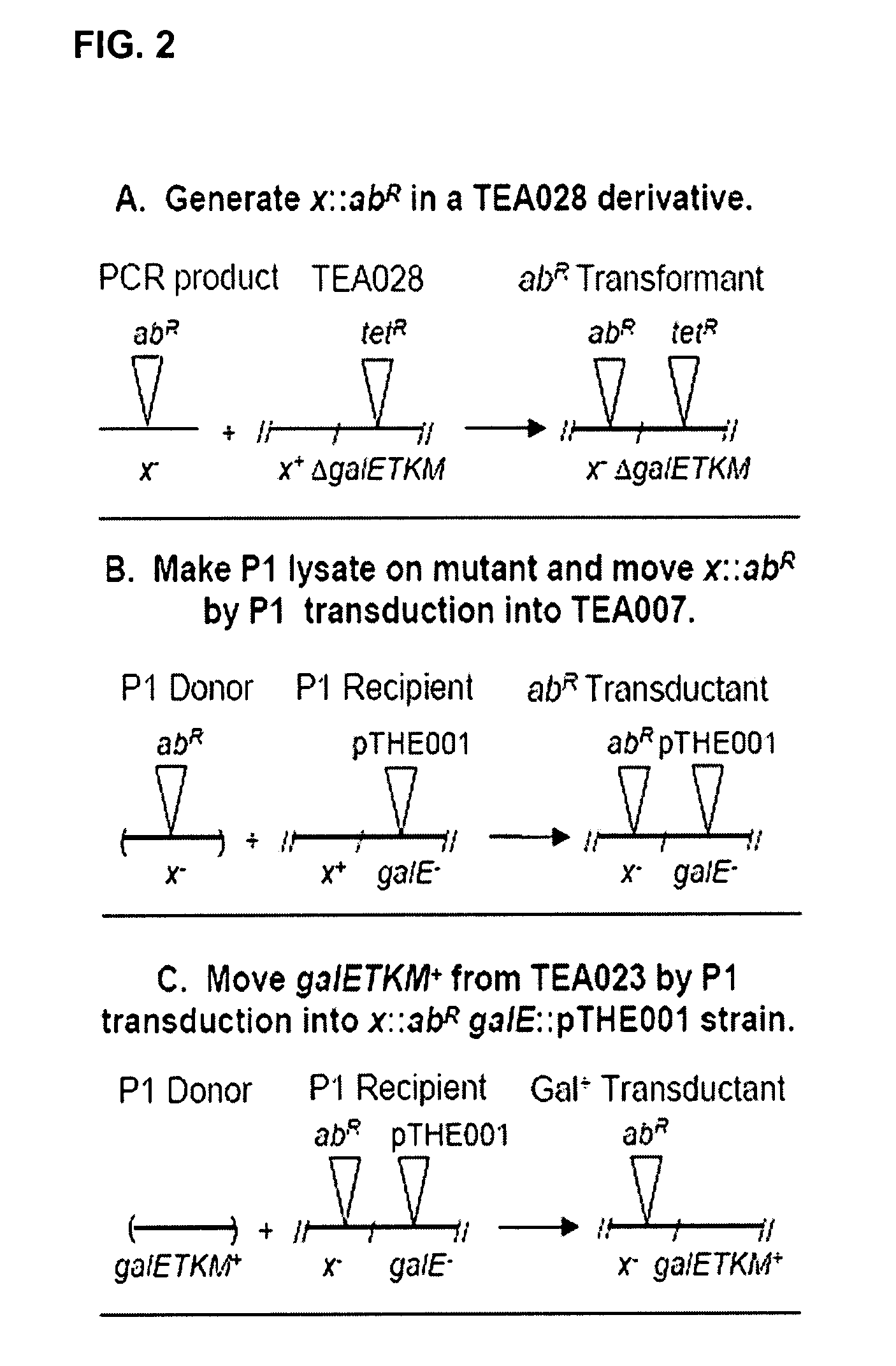Escherichia coli mutants and methods of use thereof
a technology of escherichia coli and mutants, which is applied in the field of compositions for producing gramnegative bacterial mutants, can solve the problems of difficult and expensive production and purification of recombinant proteins in sufficient amounts for use as antigens, and achieve the effects of reducing o-antigen expression, increasing susceptibility to bacteriophage p1, and increasing sensitivity to bactericidal/permeability-increasing protein (bp
- Summary
- Abstract
- Description
- Claims
- Application Information
AI Technical Summary
Benefits of technology
Problems solved by technology
Method used
Image
Examples
example 1
Production of Enterohemorrhagic E. coli O157:H7 gal Mutants
[0051]This example describes the construction of O-antigen deficient E. coli O157:H7 mutants. As described herein, the EHEC mutants produced during development of the present invention are able to adsorb the generalized transducing phage P1 and do not display growth defects in vitro. However, the EHEC mutants poorly colonize the intestine in vivo and are sensitive to bactericidal / permeability-increasing protein (BPD.
[0052]Bacterial Strains and Growth. A list of strains used in during development of the exemplary EHEC mutants are shown in Table 1. Unless otherwise noted, strains were grown in LB broth or on LB agar plates. For antibiotic selection, agar plates were supplemented with ampicillin (80 μg / ml), spectinomycin (100 μg / ml) or tetracycline (6 μg / ml). MacConkey plates with 1% galactose or M63 (22 mM KH2PO4, 40 mM K2HPO4, 15 mM (NH4)2SO4, 0.5 mg / liter FeSO4) agar plates supplemented with 0.2% galactose and 0.1% casamino ...
example 2
Production of E. coli O157:H7 gal stx2 Mutants
[0069]This example describes the construction of O-antigen deficient, shiga toxin 2 deficient E. coli O157:H7 mutants. The E. coli O157:H7 gal stx2 mutants are contemplated to poorly colonize the intestine in vivo, cause only mild diarrhea and result in reduced intestinal inflammation in comparison to isogenic E. coli O157:H7.
[0070]Bacterial Strain Construction. E. coli O157:H7 gal stx2 mutants are constructed using the PCR based “one-step gene inactivation system” adapted from Datsenko and Wanner (Proc Nail Acad Sci USA, 97:6640-6645, 2000). The pKD4 plasmid is used as a template to amplify a kanamycin resistance gene for these studies. PCR primers are designed using DNA sequences derived from E. coli O157:H7 reference strain EDL933 per a published report (Ritchie et al., Infect Immun, 71:7129-7139, 2003) and as follows: for stx2AB, JRW1 (5′-ATGAAGTGTA TATTATTTAA ATGGGTACTG TGCCTGGTGT AGGCTGGAGC TGCTTCG-3′ set forth as SEQ ID NO:10) and...
example 3
Immunization with E. coli O157:H7 gal stx2 Mutants
[0073]This example describes the administration of O-antigen deficient, shiga toxin 2 deficient E. coli O157:H7 mutants to a subject under conditions suitable for induction of an E. coli O157:H7-reactive immune response. The methods described herein are adapted from US Publication No. 2002 / 0160020 of Finlay and Potter, herein incorporated by reference.
[0074]Experimental Animals. Cattle, between the ages of 8 and 12 months are purchased from local ranchers. Fecal samples are obtained daily from each animal for 14 days. The number of EHEC O157:H7 in the fecal samples is determined by plating on Rainbow Agar. The plates are incubated at 37° C. for 2 days and black colonies are enumerated. Growth is scored from 0-5. Animals having a score of 0 (no EHEC O157:H7) are used in all experiments.
[0075]Immunization. Sixteen cattle are divided in two groups of eight animals with group 1 receiving a composition comprising live E. coli O157:H7 gal ...
PUM
| Property | Measurement | Unit |
|---|---|---|
| pH | aaaaa | aaaaa |
| pH | aaaaa | aaaaa |
| permeability | aaaaa | aaaaa |
Abstract
Description
Claims
Application Information
 Login to View More
Login to View More - R&D
- Intellectual Property
- Life Sciences
- Materials
- Tech Scout
- Unparalleled Data Quality
- Higher Quality Content
- 60% Fewer Hallucinations
Browse by: Latest US Patents, China's latest patents, Technical Efficacy Thesaurus, Application Domain, Technology Topic, Popular Technical Reports.
© 2025 PatSnap. All rights reserved.Legal|Privacy policy|Modern Slavery Act Transparency Statement|Sitemap|About US| Contact US: help@patsnap.com


